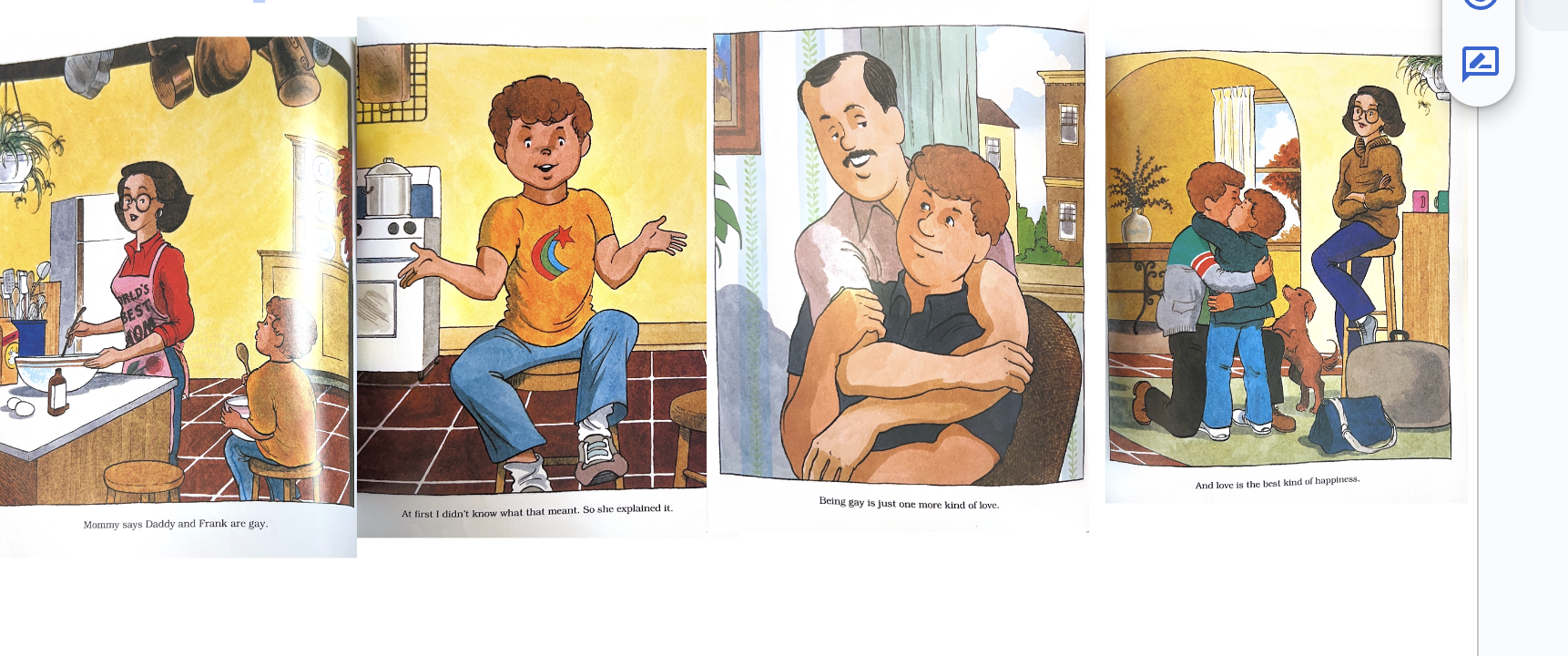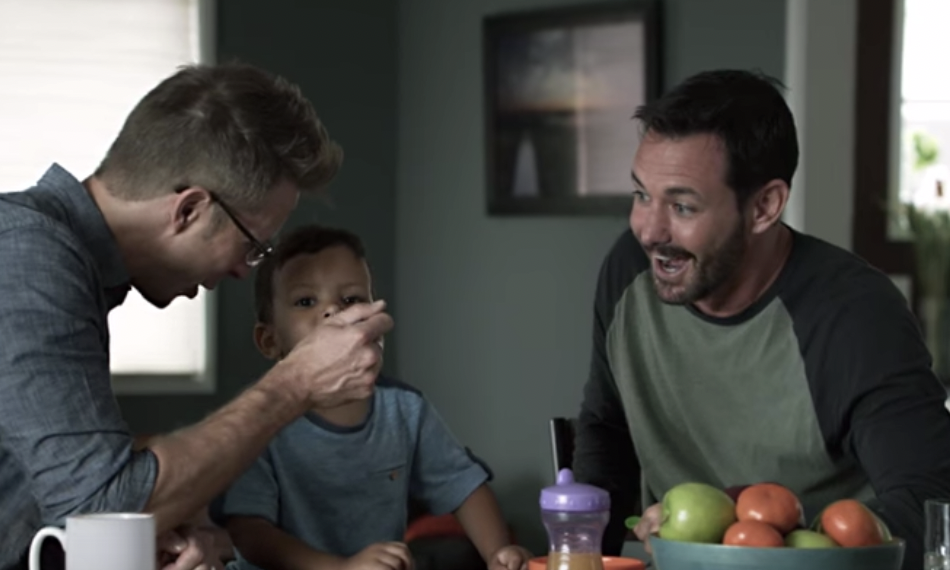Children's Books and Family Representation

Curatorial Statement
The purpose of our specific topic in the Alyson Archive is to create a space that acknowledges the need for children and young readers to see diverse and inclusive representations of families of all kinds. This exhibit is a part of our final project from our "Humanities Startup" course at Davidson College, conducted in the spring of 2024. Furthermore, it is crucial for those in the LGBTQ+ community, especially for LGBTQ+ youth, to see representation of themselves in the media. Media outlets that are intentionally making an effort to represent the LGBTQ+ community are playing an essential role in creating a positive image for an underrepresented group. It is important for younger generations to be exposed to depictions in the media that allow them to accept and celebrate themselves, welcomed into broader society with a sense of inclusivity, rather than through a framework of judgment, shame, or intolerance. The works produced by Alyson Books, specifically through their children's literature imprint (Alyson Wonderland) allows young readers to feel recognized while still portraying that who they are or who their families are is unique to them.
History & Context
Alyson Publications was founded in 1979 by Sasha Alyson, located in the South End of Boston. The first books that it published were not related to gay and lesbian identities, but instead focused on health and wellness. However, in 1980, Alyson Books published Young, Gay, and Proud! This book forged the shift in Alyson Books towards publishing books for the LGBTQ+ community and other underrepresented groups. During the 1980s and 1990s the term “gayby boom” was beginning to surface, referring to the rise of the first generation of children raised by openly out LGBTQ+ parents. During this time period, there was a spike in same-sex couples who employed emerging methods of egg and sperm donations and/or surrogacy in order to create new family structures. Adoption for same-sex couples was technically illegal up until 2015, at which point same-sex marriage was made legal across the United States. For context, in many states there are laws that couples need to be married in order to adopt a child. However, there were still same-sex couples who were able to adopt if they were able to find someone that would allow them. Same-sex couples were becoming less uncommon, which meant that more and more children began growing up outside of more traditional and conventional family structures. In an interview with Malina Simard-Halm, who is on the board of the Family Equality Council and was one of the first children born to openly gay fathers through assisted reproduction, she stated, "Normalcy is not the goal." She expanded on this claim by saying, "I think something that the queer community values is acceptance and equality, equity more broadly, and love. Those are the things we want to highlight in society, and that means accepting differences and extraordinary circumstances” (The Gayby Boom). The goal is for the children growing up with same-sex parents to understand that their families are unique, but they are still accepted and it is simply something that makes them special. This is where Alyson Publication's children’s books come into play. They allow for these children to see representation of their families while still acknowledging that they might look different from other families. Yet, this difference does not mean they deserve any less love.
Why is it important?
To begin with, these books provide comfort to kids who come from non-traditional families. Lesléa Newman tells the story of a young girl, Heather, who is raised by lesbian parents in her book Heather Has Two Mommies. Alyson Publications eventually signed the rights to both this book and Daddy’s Roommate in 1990. In Heather Has Two Mommies, Newman explains Heather’s family dynamic and the things that this young protagonist appreciates about her moms. Newman highlights many different family structure; families with two dads, families with adopted siblings, and families with divorced parents all appear within the book.
In Daddy’s Roommate, Micheal Willhoite tells the story of a little boy whose parents got divorced and whose dad now has a new male friend, Frank, who lives with them. The little boy expresses all the things he likes to do with his dad and Frank and gives the readers a glimpse at what life is like with two dads. The book concludes with the little boy’s mom telling him that his dad is gay. She and her son both have a positive reaction to the dad's sexuality and his relationship with Frank.

Sasha Alyson discussed the impact that his publications had on children in his New York Times article, “Fear the Rainbow,” on December 30, 1992. Alyson wrote, "Let's start with Nicholas, a 5-year-old with two gay fathers. For a week after he got the book, Nicholas carried ‘Daddy's Roommate’ everywhere. The book apparently made him feel included in a way the families he had seen on TV and in other books had not.” Children who grew up with gay parents during this period often felt isolated due to the lack of representation of their families in the media.
Lesléa Newman in her Horn Book Magazine article “Heather and Her Critics” (published in April 1997) also discussed the impact that her book and other LGBTQ+-affirming books have had on children. During this time period, LGBTQ+ children’s books were very hard to come by. She noted an interaction she had with a woman and her female partner who recently had become parents. The woman expressed her frustration to Newman about the lack of books accessible to them, as they wanted books they could read to their daughter and that reflected their own family structure. Newman’s book provided families such an offering, providing an opportunity to read a text that their family as a whole could relate to.
Recent Trends in Representations of Queer Families
Companies like Alyson Publications paved the way for representation for LQBTQ+ families in today’s day and age. Not only do more books now incorporate LGBTQ+ families, but there is further representation in all different types of media. One area where this representation can be seen is television. The graph to the right shows the last 10 years of regular series characters on TV. As is visible there, the amount of LGBTQ+ has had a significant increase over the past 10 years.

The streaming platform Netflix, along with other similar services, now includes a specific category for LGBTQ+ media. Within this category, many other subcategories are offered; these include: popular on Netflix, trending now, emotional LGBTQ+, High School TV Drama, Watch In One Weekend, New Releases, Movies, Shows, Only On Netflix.

Modern Family first aired in 2009 and was an influential television series for depicting queer family structures to mainstream audiences. The show presents the idea of many different family structures in a similar way as to the way in which Newman does in her book “Heather Has Two Mommies.” As noted above, some of the family structures in Newman’s book include those with adopted children, divorced and remarried parents, gay parents, lesbian parents, and single-parent households. In the series, Mitch and Cam are gay parents. The two adopt Lily, but they are not the only non-traditional family structure represented on the show. Related to this family but living under a different roof, for instance, are Gloria and Manny (who are from Colombia), Jay (who is Manny’s stepdad and Mitch's biological dad), and Joe (who is Jay and Gloria's young son). This new representation normalizes non-traditional family structures and made children who belong to these households feel more seen and comfortable as a result.

To promote their special-edition Star Wars cans that celebrated diverse families, Campbell’s Soup launched a heartwarming ad in 2015. The ad features two fathers taking turns mimicking Darth Vader's iconic line, "Luke, I am your father," while feeding their toddler son. This commercial is an example of LGBTQ+ families getting more media attention and becoming more normalized.

Citations
Alyson, Sasha. “Fear of the Rainbow.” The New York Times, 30 Dec. 1992, www.nytimes.com/1992/12/30/opinion/fear-of-the-rainbow.html. c
Cruz, Elijah. “LGBTQ+ Portrayal in the Media: Are Young People Seeing Themselves Represented?” Action for Children, www.actionforchildren.org.uk/blog/representation-matters-are-lgbtq-young-people-seeing-themselves-represented-in-the-media/. Accessed 24 Apr. 2024.
Langbert, Tosca. “The Gayby Boom is Here to Stay.” Harvardpolitics.com, 2020, harvardpolitics.com/the-gayby-boom/ Accessed 23 Apr. 2024.
Newman, Leslea. “Heather and Her Critics.” The Horn Book Magazine 73.2 (1997): 149-53. ProQuest. Web. 26 July 2023.
Waxman, Olivia B. “Campbells Soup Ad Shows Gay Dads Playing Darth Vader.” Time, 9 Oct. 2015, time.com/4068363/campbells-soup-star-wars-gay-dads-father-ad/.
